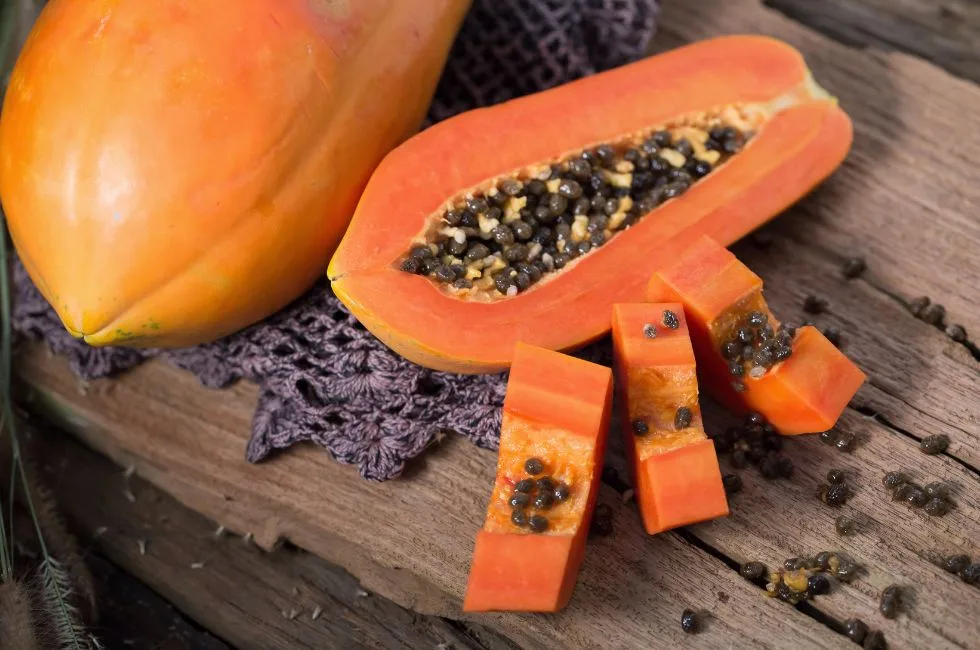Papaya is a nutritional powerhouse, rich in vitamins A, C, and E, and packed with a posse of antioxidants that can put up a fight against free radicals. But wait, there’s more! This fruit comes with a low-calorie count and a good dose of dietary fiber, making it a potentially smart snack for sugar watchers.
Now, you might be wondering, “Can I bask in the glory of papaya if I have diabetes?” Well, that’s the juicy question we’re going to explore. There’s a buzz around this fruit’s ability to dance with diabetes without stepping on any toes. Ready to find out how?
Papaya and Blood Sugar

When it comes to diabetes, it’s all about keeping that sugar in check, right? So, here’s the scoop on how papaya enters the bloodstream ballroom. Unlike some other fruits that can spike your sugar levels like a bad rollercoaster ride, papaya’s got a pretty low glycemic index. That means it releases its sugars slowly into your blood, avoiding those dreaded peaks and valleys.
But before you turn your kitchen into a papaya paradise, let’s see what the white coats and clipboards say. Research has been eyeing papaya with interest because it’s got this nifty thing called papain – an enzyme that not only tenderizes your steak but might also help regulate your sugar levels. Studies suggest that this enzyme, along with other compounds in papaya, could assist in maintaining blood sugar control, making it a potential plus for diabetics.
Now, don’t just take my word for it; researchers are still putting papaya under the microscope. However, the early signs are promising, showing that papaya may support blood sugar control, which is crucial for those with diabetes.
The Fiber Factor

Diving into the fiber-filled world of papaya, we’re not talking about a Hollywood blockbuster, but the real deal that could be a game-changer for diabetics. This tropical treasure is brimming with dietary fiber, which is like the body’s broom—sweeping through your digestive system and keeping things running smoothly.
But for those with diabetes, fiber’s superpower is its ability to slow down sugar absorption, giving you more stable blood glucose levels and a steadier energy release. It’s like having a reliable bodyguard for your blood sugar, making sure it doesn’t get into any trouble.
Papaya stands tall and proud among its fruity friends with a fiber content that can go toe-to-toe with the best of them. Eating papaya might just make your gut a happier place, and a happy gut can mean a more regulated sugar level.
Antioxidants Aplenty

Now, let’s paint a picture of papaya’s antioxidant palette. This fruit is like a canvas splashed with vibrant colors, each hue representing a different antioxidant ready to defend your body. For diabetics, this defense squad is particularly important because high blood sugar can lead to oxidative stress, which is basically like rust for your body.
Papaya’s antioxidants are the rust-proofing agents. They’re the body’s maintenance crew, working to prevent cellular damage that can lead to chronic diseases. These include the famous vitamin C, the skin-loving vitamin A, and vitamin E, which is like that friend who always has your back.
For those juggling diabetes, antioxidants play a key role in reducing inflammation and helping the body to manage blood sugar more effectively. It’s like having an internal peacekeeping force, making sure everything runs smoothly and keeping inflammation in check.
So, while we’re not saying papaya is a miracle cure, its antioxidant profile is definitely something to cheer about. It’s another reason why this fruit might be a worthy addition to a diabetes-friendly diet.
Is Papaya Too Sweet?

Here comes the question: “Is papaya too sweet for someone with diabetes?” Well, it’s not as straightforward as a yes or no. You see, papaya does contain natural sugars, but it’s also like that well-intentioned friend who balances the sweetness with a healthy dose of fiber.
The sugars in papaya aren’t the bull-in-a-china-shop kind; they don’t barge into your bloodstream causing havoc. Thanks to the fiber, they’re more like a well-behaved guest, entering slowly and mingling nicely without causing a scene.
But here’s the deal: moderation is key. A slice of papaya here and there can be part of a balanced diabetic diet. The trick is to not go overboard and to pair it with other foods that can help offset the sugar content, like a handful of nuts or some Greek yogurt.
So, while papaya is on the sweeter side, it’s all about the portion size and what you pair it with. Eating papaya in moderation and as part of a mixed meal can make all the difference.
Serving Suggestions

If you’re nodding along thinking, “Alright, papaya sounds like a pretty sweet deal,” then let’s chat about how to serve it up. When you have diabetes, you know the drill: planning is your best friend. So, let’s plan on making papaya your new pal.
First off, consider the timing. Having papaya as part of your meal can be better than eating it solo. Why? Because it’s all about the company it keeps. Pair it with some protein or fat, and you’ll have a slower release of sugars, which is exactly what you want.
Next up, let’s talk portion control. Instead of a mammoth bowl of papaya, think of a small, colorful addition to your plate. A cup of diced papaya could be a good start. And hey, why not get creative? Throw it into a salad, blend it into a smoothie with some spinach and avocado, or top it on a diabetic-friendly dessert.
And here’s a fun idea: freeze little papaya cubes. They make for a refreshing treat or can jazz up a glass of water, making hydration a tropical moment.
Precautions & Considerations
Papaya might seem like it’s all fun and games, but let’s not forget to play it safe. There are times when this fruit might not be the best choice. For instance, if you have a known allergy to latex, you might also react to papaya because of the enzyme papain.
Also, if you’re on certain medications, especially those that affect blood sugar levels, you’ll want to have a chat with your doctor. Papaya could potentially affect how your meds work, and we definitely don’t want any party crashers in our diabetes management.
And remember, natural doesn’t always mean risk-free. Just because it’s a fruit doesn’t mean it’s a free-for-all. It’s still about balance and fitting it into your overall carb allowance.
So, while papaya is generally a good guy in the world of fruits, it’s important to keep these considerations in mind. After all, managing diabetes is about finding what works for you and your unique health puzzle.
Frequently Asked Questions (FAQs)
Papaya has qualities that might be beneficial, like fiber and a low glycemic index, which can help manage blood sugar levels. But it’s not a standalone treatment; think of it as part of a team effort in your diet.
Portion size is personal, depending on your overall diet and blood sugar goals. A common starting point is about a cup of diced papaya, but it’s best to consult with a healthcare provider for advice tailored to you.
It might. Since papaya can affect blood sugar levels, it could interact with your meds. Always best to play it safe and talk with your healthcare provider.
Absolutely! Beyond blood sugar management, the antioxidants and vitamins in papaya can support overall health, which is a big win for anyone, not just diabetics.
Now it’s your turn! Have you tried papaya in your diabetic diet? Got any tasty recipes or tips to share? Or maybe you have questions we didn’t cover? Drop your thoughts and queries in the comments below.




